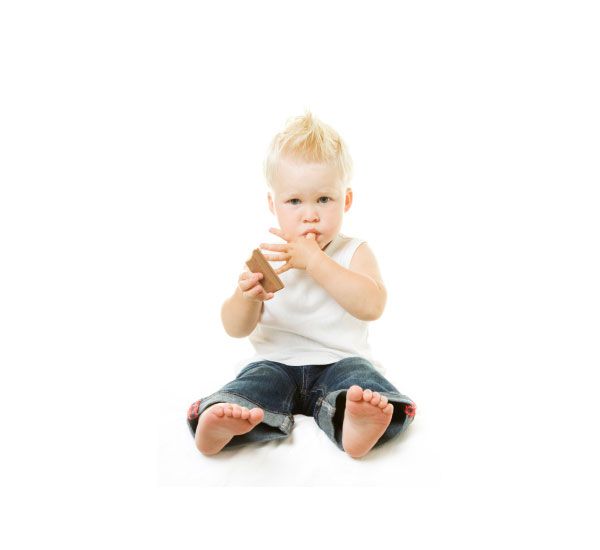Making sure kids eat a healthy diet can be tricky these days, and it’s not made any easier by the manufacturing of foods and beverages with harmful hidden ingredients. Caffeine, a stimulant drug, is one ingredient that can be harmful if kids consume too much, and you’ll find it hidden in a range of foods and drinks children love, like chocolate and cola drinks.
It’s likely you’ve given your child a dose of caffeine at some point without even realising it. When it’s consumed in moderation, the immediate effects of caffeine appear to be safe, even for children. But troublesome side effects of caffeine can occur when children consume too much. You’ll be better able to control your child’s caffeine intake if you’re aware of the caffeine content of all the different foods and drinks in which it might be hidden, and know how much caffeine is too much when it comes to kids.
A drug? What are the effects of caffeine?
 ‘Caffeine, a drug?’ you say. It’s a naturally occurring drug, but a drug none-the-less. Caffeine is one of a class of drugs known as psychoactive drugs which alter the body and mind, for example by influencing mood and thought patterns. Others psychoactive drugs include alcohol and marijuana. If you’re not used to the idea of giving your child mind altering drugs, that’s probably because caffeine is the only psychoactive drug legally available to children.
‘Caffeine, a drug?’ you say. It’s a naturally occurring drug, but a drug none-the-less. Caffeine is one of a class of drugs known as psychoactive drugs which alter the body and mind, for example by influencing mood and thought patterns. Others psychoactive drugs include alcohol and marijuana. If you’re not used to the idea of giving your child mind altering drugs, that’s probably because caffeine is the only psychoactive drug legally available to children.
Caffeine is not only legal, caffeinated products are often marketed aggressively to curious little minds, and they’re easy to reach on supermarket shelves for curious little hands. A quick check of the packaging label will show you that every bar of chocolate and every can of cola contains some caffeine. However, in some cases not all the caffeine is listed on the product label. The caffeine content of some additives such as guarana (which naturally contains 40-80mg of caffeine per gram), cocoa and kola nut, may not be included in the caffeine total.
 |
Be aware of common caffeine containing foods and beverages, particularly cola drinks, energy drinks and chocolate. |
 |
Check the nutritional panel of foods and beverages for caffeine. |
 |
Check the nutritional panel of foods and beverages for caffeine containing substances including guarana, kola nut and cocoa, the caffeine contents of which may not be included in the caffeine total. |
 |
Calculate the caffeine content of what your child consumes, based on the size of the serving they consume. |
So what’s the rest of Australia doing?
Research shows us that despite caffeine being a drug, Aussie kids are consuming caffeine in food and drinks from a very young age. If you heard your next door neighbour was giving their three-year-old caffeine (or any other drug), you’d probably be appalled and may not believe it. But when you consider that every cola drink, tea, coffee and chocolate bar a kid consumes contains a dose of the stimulant drug, it’s obvious that most kids consume caffeine.
The immediate effects of moderate amounts of caffeine are relatively harmless. Children do not develop caffeine dependence or symptoms of caffeine overdose like nausea and vomiting after eating a bar of chocolate or drinking a glass of cola. But symptoms like headaches and difficulty sleeping can develop when kids overdo-it on the caffeine, and little is known about how moderate caffeine consumption over a long period of time affects children.
Keeping kids away from caffeine is difficult. Caffeinated products usually look safe and appealing, which may make it hard to decide how much caffeine, if any, your child should be gobbling down.
How much is too much?
How much caffeine is safe for a child depends how big they are. For both little kids and teenagers, the recommended caffeine intake is 2.5 mg of per kg of body weight each day. That’s 37 mg of caffeine a day for a kid who weighs 15 kg – or about the amount of caffeine found in a can of cola. A kid who weighs 50 kg can consume 125 mg of caffeine per day, meaning they can consume a can of energy drink or a strong cup of coffee (although we advise that you don’t feed your child these – milk and water are much healthier drinks for your child to consume).
On average, Australian kids consume caffeine at safe levels and get most of their caffeine from cola drinks and tea. A typical Aussie 3-year-old consumes about 3.4 mg of caffeine each day (but is likely to weigh 20 kg and could therefore safely consume up to 50 mg). Children aged 4–8 years get an average of 8 mg of caffeine per day. Even at 14–16 years, when kids are starting to stay up late studying and drinking coffee, the average Aussie teen consumes 42 mg of caffeine.
But hidden in averages are a proportion of Australian children who do not consume any caffeine, as well as those who drink too much caffeine.
 |
Calculate how much caffeine your child/children can safely consume based on their weight. |
 |
Be familiar with the quantities of different caffeine-containing foods and beverages your child can safely consume on a daily basis, for example a 15kg child could consume the quantity of caffeine in a cola drink safely. |
But if it gives you wings, it may have too much caffeine
 A word of warning to parents whose kids consume energy drinks: your child is more likely to be consuming too much caffeine. Recently, health professionals have started to raise some concerned eyebrows about the effects of ‘the juice’ (aka, ‘the energy drink’) on teenagers (not to mention younger children!). Caffeinated energy drinks are everywhere now, and they’re marketed with exciting and sometimes pretty sexy packaging, which teenagers don’t seem to mind at all. But unlike cigarettes and other legally available drugs, caffeine-containing energy drinks don’t come with a label warning children or their parents about the potentially dangerous effects of caffeine.
A word of warning to parents whose kids consume energy drinks: your child is more likely to be consuming too much caffeine. Recently, health professionals have started to raise some concerned eyebrows about the effects of ‘the juice’ (aka, ‘the energy drink’) on teenagers (not to mention younger children!). Caffeinated energy drinks are everywhere now, and they’re marketed with exciting and sometimes pretty sexy packaging, which teenagers don’t seem to mind at all. But unlike cigarettes and other legally available drugs, caffeine-containing energy drinks don’t come with a label warning children or their parents about the potentially dangerous effects of caffeine.
As if all the sugar wasn’t bad enough (a 250ml can of soft drink contains up to 9 teaspoons of sugar, and most energy drinks contain five teaspoons of sugar per 250ml ), the amount of caffeine in energy drinks is typically about the same amount of caffeine in a cup of coffee (around 80 mg). So one can of energy drink per day would be the maximum safe limit for an adolescent who weighs up to 60kg. However, the caffeine content of energy drinks varies markedly between brands. High caffeine energy drinks may contain as much as 300 mg of caffeine, a nasty and potentially dangerous kick in the pants for any growing body weighing less than 120 kg! Paradoxically drinks containing larger quantities of caffeine may be marketed under the seemingly-healthful name of dietary supplements.
 |
Be aware that energy drinks typically contain the same amount of caffeine as a cup of coffee, and sometimes much more. This is more than the safe limit for young children, and even teenagers can safely drink no more than one energy drink per day. |
 |
Consider both the sugar and caffeine content of energy drinks and soft drinks. Even if the caffeine content is within the safe limit, the sugar content may pose health risks if energy or soft drinks are consumed regularly. |
Some experts believe that no caffeine is the safest option for children, until further research about how it affects growing bodies is conducted. There are many unanswered questions when it comes to caffeine, such as if consuming moderate amounts of caffeine at an early age may make a child more likely to become dependent on or addicted to caffeine. In the absence of research and evidence, a number of European countries (including Denmark, Norway, Sweden, Germany and Turkey) have banned caffeine drinks entirely or put restrictions on the sale of caffeine-containing energy drinks to kids under 15. Australia has also recently banned five brands of energy drink with very high caffeine content.
 |
Be aware that some health professionals believe information about the effects of caffeine on children is insufficient to determine whether or not it is safe. They recommend no caffeine as the safest option, until more research is conducted. |
Don’t let caffeine replace healthy drinks for children
It’s also important to remember that caffeine contains nothing of nutritional value and it suppresses the appetite. If caffeinated beverages replace milk or water, children miss out on micronutrients calcium and proper hydration. If a child does not feel hungry because they’ve just had an appetite-suppressing dose of caffeine, they may not eat enough to grow to their full potential.
If caffeine comes in the form of a sugary, high-calorie energy drink, all the calories that go down with the caffeine can contribute to health conditions such as obesity and type 2 diabetes, not to mention the damage this causes to their teeth. All that sugar may also cause your child to develop a preference for unhealthy, sugary foods. If your child is consuming these drinks regularly, it’s probably time to say ‘when’.
 |
Ensure healthy drinks like water and milk, which hydrate children and contain important micronutrients are the main drinks consumed by your child. |
 |
Limit the quantity of sugary caffeinated beverages your child consumes. |
 |
Ensure your child does not replace meals with appetite-suppressing caffeinated beverages. |
Helping kids consume caffeine safely
 Where kids are involved, it is always safer to err on the side of caution. Evidence shows that caffeine overdose can occur in children who consume 1g of caffeine, that’s about seven strong cups of coffee or three high-caffeine energy drinks. Caffeine overdose is potentially fatal, so it’s important to be familiar with the symptoms that may occur in children who have consumed too much caffeine. They include:
Where kids are involved, it is always safer to err on the side of caution. Evidence shows that caffeine overdose can occur in children who consume 1g of caffeine, that’s about seven strong cups of coffee or three high-caffeine energy drinks. Caffeine overdose is potentially fatal, so it’s important to be familiar with the symptoms that may occur in children who have consumed too much caffeine. They include:
- Involuntary shaking;
- Nausea and/or vomiting;
- Rapid heartbeat or irregular heartbeat;
- Confusion;
- Panic attacks;
- Seizures.
If your child is experiencing any of these symptoms, seek medical attention.
 |
Seek medical attention if your child experiences tremor, nausea and/or vomiting, changes to their heartbeat, confusion, a panic attack or a seizure. These may be symptoms of a caffeine overdose. |
Caffeine crazy; the effects of caffeine on children’s behaviour
So what are the side effects of caffeine? Kids are generally affected by caffeine in the same way as adults. Children (excluding infants) have been shown to metabolise (process) caffeine faster than adults. However, kids’ bodies are much smaller than adults’ bodies so they should not be consuming the same size servings as adults.
The behavioural effects of too much caffeine include anxiety, irritability, restlessness and excitement. While caffeine can increase alertness in the immediate term, it may cause lethargy or feelings of tiredness once the immediate effects wear off about 12 hours after it is consumed. A child who uses caffeine to keep themselves awake at night is likely to feel tired and lethargic the following day. The behavioural effects of caffeine may add up to underperformance at school. So help your child and their teacher out, and keep them away from the coffee pot (or cola) before the bell.
Help yourself out and ensure the caffeine’s also out of sight before bedtime because, as you may already be aware, this drug promotes wakefulness and can interfere with a good night’s sleep. Kids who consume caffeine may sleep poorly and be more likely to wet the bed. It’s recommended that children who wet the bed avoid drinking caffeinated beverages.
 |
Be aware that behaviours like anxiety, irritability, restlessness and tiredness may be behavioural effects of caffeine. |
 |
Avoid giving children caffeine-containing products before school or during the school day. |
 |
Be aware that caffeine may reduce sleep quality and increase the likelihood of bedwetting. |
 |
Avoid giving children caffeine containing products before bed. |
Behavioural disorders
Caffeine is also associated with some behavioural disorders, but it is not thought to cause them. For example, caffeine consumption is not believed to cause hyperactive behaviour in children with ADHD, although those with the condition are more likely to consume caffeine. One study reported that adolescents with ADHD were nearly twice as likely to consume caffeine compared to adolescents who did not have ADHD. Another study found that those with ADHD were more likely to abuse caffeine than those without ADHD.
Research about the ways in which caffeine affects the behaviours of children with ADHD has produced conflicting results with some showing that it increases hyperactive behaviour in this group, and others that it controls hyperactive behaviour (which most evidence tends to suggest). However, the detrimental effects of caffeine use in children with ADHD are potentially greater as the prescription stimulants they take for the condition may interact with or enhance the effects of caffeine.
Kansas City Shuffle: switching caffeine-containing beverages for healthy drinks
 Sound like your child needs to cut down on their caffeine? Remember small amounts seem to be okay, but despite being within easy reach on the supermarket shelf, caffeine is an addictive drug. When consumed in large quantities, there are health risks of caffeine and suddenly quitting may cause withdrawal symptoms of caffeine addiction. These typically commence 24 hours after the last dose of caffeine and persist for at least 36 hours. The most common caffeine withdrawal symptom is headaches. Others include fatigue, muscle pain and anxiety.
Sound like your child needs to cut down on their caffeine? Remember small amounts seem to be okay, but despite being within easy reach on the supermarket shelf, caffeine is an addictive drug. When consumed in large quantities, there are health risks of caffeine and suddenly quitting may cause withdrawal symptoms of caffeine addiction. These typically commence 24 hours after the last dose of caffeine and persist for at least 36 hours. The most common caffeine withdrawal symptom is headaches. Others include fatigue, muscle pain and anxiety.
If your child has been having energy drinks or other sources of caffeine every day, you may need to wean them off it slowly! Try swapping their caffeinated drinks with milk or water. They may ‘pipe up’ at first, but with time they will start to change their habits for the better. Kids generally have plenty of natural energy anyway, so they don’t really need caffeine kicks.
 |
Be aware that caffeine is an addictive drug and stopping caffeine consumption might cause withdrawal symptoms like headaches, fatigue and muscle pain. |
 |
If your child consumes too much caffeine, reduce their consumption slowly to ensure they do not experience withdrawal effects. |
Download the caffeine checklist
References
- Oddy WH, O’Sullivan TA. Energy drinks for children and adolescents- erring on the side of caution may reduce long term health risks. BMJ. 2010; 340: 64. (Abstract)
- Department of Health and Ageing. 2007 Australian National Nutrition and Physical Activity Survey- Main Findings. 2008. [cited 27 January 2012]. Available from: URL Link
- Nawrot P, Jordan S, Eastwood J, Rostein J, Hugenholt A, Feeley M. Effects of caffeine on human health. Food Addit Contam. 2003; 20(1): 1-30. (Abstract)
- University of Delaware. Effects of Caffeine. 2012. [cited 27 January 2012]. Available from: URL Link
- British Columbia Community Nutrition Council- School Food Advisory Committee. Caffeine and the student body. 2007. [cited 27 January 2012]. Available from: URL Link
- Logan R. Hey ‘cool kid’, where’s your drink bottle? Sports Nutr. 2006. [cited 2010, July 3]. Available from: http://www.ausport.gov.au/__data/assets/pdf_file/0010/144937/hey_cool_kid.pdf
- Leon MR, Effects of caffeine on cognitive psychomotor and affective performance of children with Attention-deficit/hyperactivity disorder. J Att Disorders. 2000; 4(1): 27-47. (Abstract)
- Australian Drug Foundation. Caffeine facts. 2011. [cited 26 March 2012]. Available from: URL Link
- Logan R. Hey ‘cool kid’, where’s your drink bottle? Sports Nutr. 2006. [cited 27 January 2012]. Available from: URL Link
- National Institutes of Health. Caffeine in the diet. 2009. [cited 2010, June 23]. Available from: URL Link
- Reissig CJ, Stain EC, Griffiths RR. Caffeinated energy drinks—A growing problem. Drug and alcohol dependence. 2009; 99: 1-10. (Full Text)
- Walker LR, Abraham AA, Tercyak KP. Adolescent caffeine use, ADHD and cigarette smoking. Children’s Health Care. 2010; 39(1): 73-90. (Abstract)
- Seifert SM, Schaechter JL, Hershorin ER, et al. Health effects of energy drinks on children, adolescents and young adults. Pediatrics. 2011; 127: 511-29. (Full Text)
- South Australia Health. Help your kids to drink water- the original cool drink. 2010. Available from: URL Link
- Vande Walle J, Rittig S, Bauer S et al. Practical Consensus Guidelines for the management of enuresis. Eur J Pediatr. [epub ahead of print] (Abstract)



 (11 votes, average: 4.64 out of 5)
(11 votes, average: 4.64 out of 5) 






